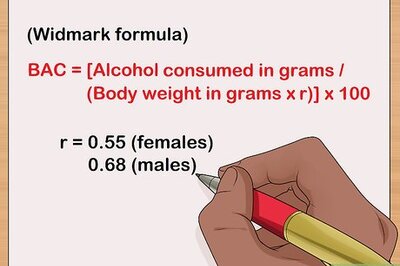
views
Playing the Joker
Use the joker in place of any tile in the game. The joker can be used as any number of any color and can be played at any time, including on your initial “meld” (a term used for both of-a-kind groups and numerical runs). If you use it on your first turn, it scores as the numerical value of the tile you’re substituting it with. This is according to the official Rummikub rules, as of 2019. In earlier versions, you couldn’t always play the joker when “going out” in your initial meld. In some versions of the rules, the initial meld must add up to 30. In others, it’s up to 50.
Immediately play any joker you free from the table. You cannot put jokers from the table back into your hand. You must be able to play at least one tile from your hand to be able to play a freed joker from the table (or to rearrange any tiles, for that matter). You cannot use any tiles, including jokers, from the table while making your initial 30-point meld(s). In other (stricter) versions of the rules, you have to place the joker in a new meld with at least two tiles from your own hand.
Score the joker as 30 points if it’s in your hand at the end of the game. When one player says “Rummikub” and finishes the round, all the other players add up the tiles still left in their hands. Since the lowest score ultimately wins, holding on to a joker for too long can be risky business!
Replacing a Joker
Replace jokers in numerical runs with the exact tiles they represent. The simplest way to replace a joker is to swap it for a tile from your own hand. This is legal across all rule sets. For example, if you had a blue 1, blue 2, blue 3, Joker, and blue 5, you could pick up the joker by replacing it with a blue 4.
Replace jokers in of-a-kind groups with one or both missing tiles. In some rule sets, jokers in 3-of-a-kind groups must be replaced by both tiles they could represent. For example, in a group with a joker, a blue 4, and a red 4, you would have to play a black 4 and a yellow 4 from your own hand to pick it up. In less strict ones, you can just put down a single tile.
Rearranging Melds to Free a Joker
Break up runs into sets with at least 3 tiles to free a joker. In the most recent version of the rules, you can pick up a joker as long as all the tiles left on the board are in a legal position. So, for example, if you had a numerical run that went 1, 2, 3, J, 5, 6, 7; then you could just pick up the joker, leaving the 1, 2, 3, and 5, 6, 7 runs intact. You can also add tiles to sets to make them long enough. If the original run was only 2, 3, J, 5, and 6, you could add a 1 and a 7 to break it up into the two runs from the earlier example. If the joker is on the end of a run that's three or more tiles long, you can pick up the joker.
Take jokers off of 4 of-a-kind groups. Since the tiles just need to be in a legal meld, you can take jokers off of 4 of-a-kind groups without adding anything to the table. Once again, this is only in the more recent versions of the rules.
Break runs into of-a-kind groups to free a joker. If you have a black 1, 2, J run and can legally place the 1 and 2 elsewhere (like of-a-kind groups that don't have black), you can take the joker and put the 1 and 2 into other melds.
Historic Rules
Melds with jokers cannot be rearranged or taken from. Rummikub is a spin on the card game Rummy, which has much stricter rules. For example, if you want to break up or take tiles from a meld with a joker, you have to replace the joker first. You can still add tiles onto the ends of melds with a joker. In the hardest version of the game, including in "tournament" rules, the tile has to come from your own hand. That means, if both tiles that can replace the joker are already on the board, the meld with the joker is "locked in" and can only be added to.
Jokers in of-a-kind groups must be replaced by all missing tiles. In Rummikub tournaments, if a joker is the third tile in an of-a-kind group, you have to replace it with both missing tiles. For example, if you had a blue 3, red 3, and a joker, you would need to put down the yellow 3 and black 3 to free it.
To free a joker, you must use tiles from your own hand. While more recent versions of the rules allow you to replace the joker with a tile from the board or from your hand, originally you could only replace a joker with a tile you drew from the deck.
Melds can only have one joker in them at a time. This is another old Rummy rule that was mostly phased out of Rummikub rule sets. You cannot use two jokers to create a new meld, nor can you put a joker onto a meld that already has one joker. So, for example, you couldn’t add a joker and red 6 to a red 3, joker, red 4 meld. This makes sense in tournament rules, since it gives playing a joker a major drawback (locking up tiles in a meld). If you can't play two jokers in one meld, you can't just "sacrifice" one color or set of numbers.
Special Jokers
Double joker This tile takes the place of any two tiles that go together in a meld. In an of-a-kind group, you must put down two other tiles along with the double joker, since all melds must have at least 3 tiles. In numerical runs, the double joker takes the place of two consecutive tiles. Of-a-kind groups with the double joker can only be three tiles long. This is because of-a-kinds max out at four (since there are only four colors in the deck), and the double joker takes the place of the two other colors.
Color change joker The color change joker can only be used in numerical runs. It replaces any tile in the game, like the regular joker, but once you put it down the following tiles must be a different color than the original run. For example, you could have a run that starts with a blue 3, blue 4, and color change joker, then continues with a red 6 and red 7.
Mirror joker To place a mirror joker, you have to put down two identical numerical runs on either side of it. For example, you could put down a blue 3, blue 2, mirror joker, blue 2, and blue 3. The runs must continue to mirror each other as more tiles are put down. So if you picked up a 3 on one side, you’d have to pick up the 3 on the other. The mirror joker has a value of 0 in the initial meld and in the final score. If you use a color change joker, the color change has to be the same on each side. So if you had red 6, color change joker, blue 5, and blue 4 on one side of the mirror joker, the other side would have to be blue 4, blue 5, color change joker, and red 6. Regular jokers and double jokers don’t have to be mirrored by another joker tile. They only have to be mirrored by the tile they represent. For example, you could put down a yellow 1 and 2 on one side, then mirror it with a double joker.

















Comments
0 comment